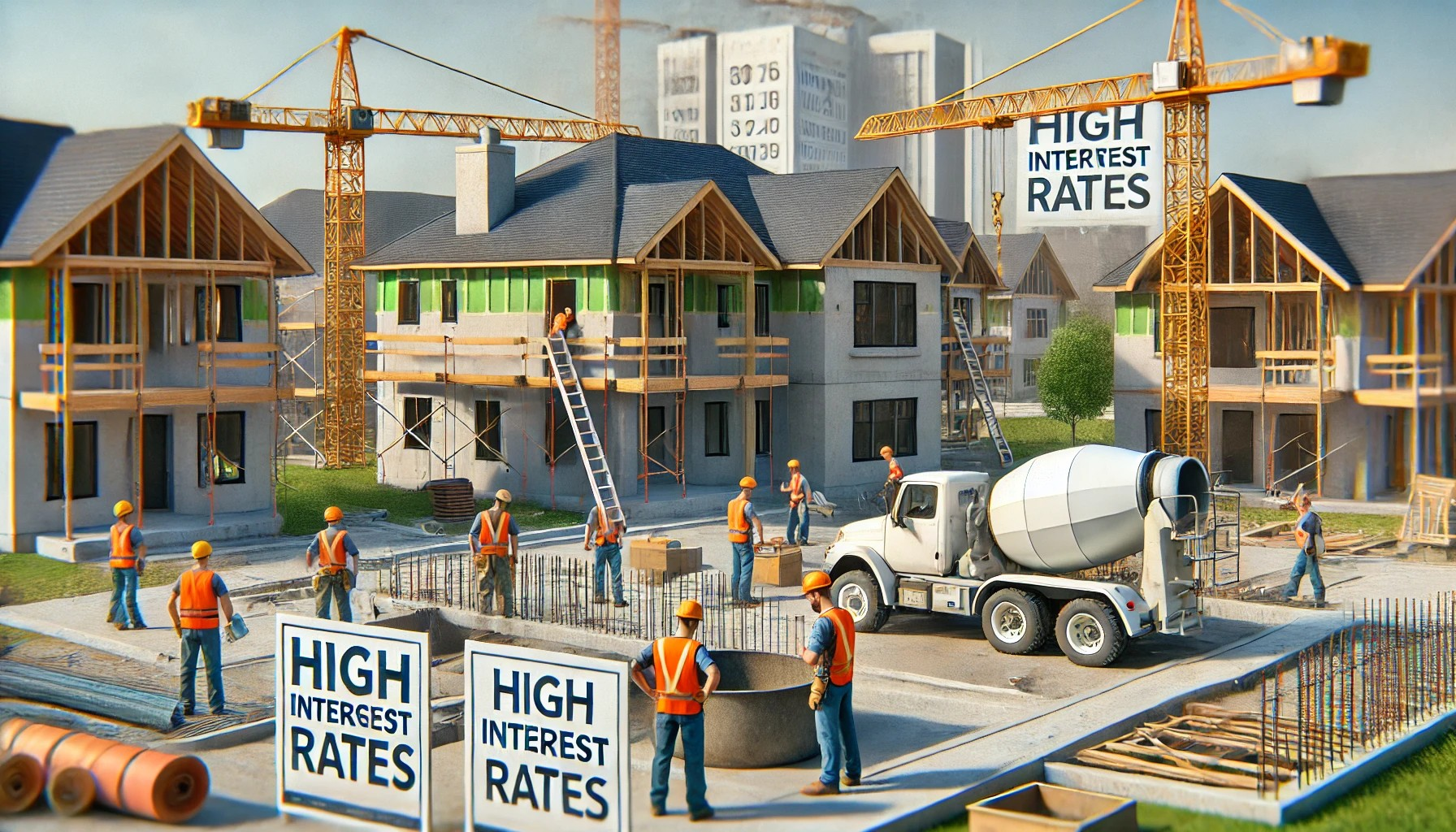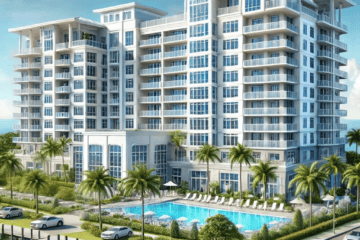
Single-Family Home Construction Drops Amid High Interest Rates
The recent surge in high interest rates has created a significant shift in the housing market, with single-family home construction experiencing a notable decline. This trend is concerning for many prospective homebuyers and builders who are finding it increasingly difficult to navigate the financial landscape. Higher borrowing costs have led to reduced affordability, directly impacting the decision-making process for both builders and home buyers. The ripple effect of these changes is being felt across the nation, with many stakeholders in the real estate industry adjusting their strategies to cope with the new economic reality.
At Elite100, we understand the challenges this presents for real estate professionals. Our members, who are among the top real estate agents in the United States, are equipped with the knowledge and tools to navigate these turbulent times. Through our exclusive benefits, services and extensive network, we provide the support necessary to adapt to market changes and continue delivering exceptional service to clients. Whether you are a buyer, seller, or builder, our agents are here to help you make informed decisions in a fluctuating market.
The Impact Of High Interest Rates On Construction
High interest rates have a profound impact on the construction of single-family homes. When borrowing costs rise, the overall expense of building new homes increases. This escalation in costs can deter builders from starting new projects, leading to a decline in the number of new homes being constructed. For many builders, the increased financial burden outweighs the potential profits, and closing costs and causing them to halt or delay construction plans.
Furthermore, higher interest rates reduce the pool of potential homebuyers. As mortgage rates climb, monthly mortgage payments become less affordable, deterring many prospective buyers from entering the market. This reduction in housing demand further up home prices and discourages builders, who rely on a steady stream of buyers to justify new construction projects. The decreased demand and increased costs create a challenging environment for the construction industry, leading to fewer single-family homes being built.
The relationship between interest rates and construction is also influenced by the availability of credit. Tighter lending standards often accompany higher interest rates, making it more difficult for builders to secure the necessary financing for new projects. This limited access to credit compounds the issue, as even those builders willing to take on higher costs may find themselves unable to obtain the funds needed to proceed with construction.
Regional Variations In Construction Activity
The impact of high interest rates on single-family home construction varies across different regions. Areas with higher housing demand and limited housing supply may continue to see some level of construction activity, albeit at a reduced pace. Conversely, regions with lower demand and higher housing inventory levels may experience a more pronounced decline in new home construction. This regional variation underscores the importance of local market conditions in determining the extent of the slowdown in construction activity.
In some metropolitan areas, where housing shortages are more acute, the decline in construction may be less severe. Builders in these regions may be more willing to absorb higher costs due to the strong demand for housing. However, even in these areas, the overall pace of new construction is likely to slow as builders become more cautious in their investments.
Rural areas and smaller cities may experience a more significant drop in construction activity. These regions often have less robust demand for new housing, making the increased costs and reduced affordability more impactful. Builders in these areas may decide to delay or cancel projects altogether, leading to a more noticeable decline in single-family home construction.
Builders’ Strategic Adjustments
In response to these challenges, some builders are exploring alternative strategies to maintain profitability. This includes focusing on smaller, more affordable homes that are less affected by higher mortgage rates. Additionally, some builders are shifting their focus to multi-family units or rental properties, which may be more resilient to changes in interest rates. These strategic adjustments help builders navigate the current market conditions while continuing to meet the needs of homebuyers.
Despite these efforts, the overall outlook for single-family home construction remains cautious. Builders and buyers alike are closely monitoring mortgage rate trends and economic indicators to gauge future market conditions. The uncertainty surrounding interest rates adds an additional layer of complexity to the decision-making process, making it essential for all stakeholders to stay informed and adaptable.
Builders are also increasingly incorporating cost-saving measures and efficiency improvements into their projects. This can include using prefabricated components, adopting new construction technologies, or streamlining project management processes. By reducing construction costs, builders aim to offset some of the financial pressures caused by higher interest rates, allowing them to continue building new homes despite the challenging economic environment.
Long-Term Implications For The Housing Market
The decline in single-family home construction due to high interest rates has significant long-term implications for the housing market. One of the primary concerns is the potential for a housing shortage. As fewer new homes are built, the existing housing inventory may struggle to meet the ongoing demand, leading to increased competition and higher home prices. This situation could exacerbate affordability issues, particularly for first-time homebuyers and those with limited financial resources.
Additionally, the slowdown in construction could impact the broader economy. The construction industry is a significant contributor to economic growth, providing jobs and stimulating local economies. A prolonged decline in construction activity could lead to job losses and reduced economic output, further complicating the recovery process. Policymakers and industry leaders will need to collaborate to address these challenges and support the housing market through targeted interventions and initiatives.
Environmental considerations also play a role in the long-term outlook for single-family home construction. As the market adjusts to higher interest rates, there is an opportunity to prioritize sustainable building practices and energy-efficient homes. This shift could help mitigate the environmental impact of construction while providing long-term cost savings for homeowners. Embracing green building standards and technologies will be crucial in shaping a resilient and sustainable housing market for the future.
Economic Factors Influencing Interest Rates
Several economic factors contribute to the fluctuation of interest rates, directly impacting the housing market. Inflation is a primary driver, as the Federal Reserve often raises interest rates to control rising prices. When inflation increases, the cost of borrowing also goes up, affecting mortgage rates and construction loans. This relationship between inflation and interest rates underscores the interconnectedness of the broader economy and the housing market.
Economic growth and employment levels also influence interest rates. In a robust economy with low unemployment, the Federal Reserve may increase rates to prevent overheating. Conversely, in a sluggish economy, rates may be lowered to stimulate borrowing and investment. These macroeconomic conditions affect builders’ confidence and their willingness to undertake new projects, as they assess the potential risks and returns associated with higher borrowing costs.
Global economic trends can also impact domestic interest rates. Factors such as international trade policies, geopolitical tensions, and global financial markets play a role in shaping the economic environment. For instance, changes in foreign investment flows or shifts in global demand for commodities can influence interest rates, subsequently affecting the construction industry. Builders must stay attuned to these broader economic trends to navigate the complexities of the housing market effectively.
Government Policies And Regulatory Factors
Government policies and regulations significantly influence the construction of single-family homes. Zoning laws, building codes, and land use policies dictate where and how new homes can be built. These regulations can either facilitate or hinder construction activity, depending on their complexity and stringency. In times of high interest rates, lenient policies can help mitigate some of the financial challenges faced by builders.
Incentives and subsidies provided by federal, state, and local governments also play a crucial role. Programs that offer tax breaks, grants, or low-interest loans for construction can help offset the impact of high interest rates. These incentives can encourage builders to continue developing new projects, even in a less favorable economic environment. Policymakers must carefully design these programs to ensure they effectively support the construction industry without causing unintended market distortions.
Regulatory barriers, such as lengthy permitting processes and stringent environmental regulations, can increase the cost and time required for construction. Simplifying these processes and reducing bureaucratic hurdles can help builders cope with the challenges posed by high interest rates. By streamlining regulations, governments can create a more conducive environment for new home construction, supporting both builders and homebuyers.
Market Demand And Buyer Behavior
Market demand and buyer behavior are critical factors influencing single-family home sales and construction. High interest rates can dampen demand as potential buyers face higher mortgage costs. This reduced affordability can lead to a slowdown in home purchases, affecting builders’ sales projections and their willingness to start new projects. Understanding buyer behavior in response to interest rate changes is essential for predicting market trends.
Demographic trends also play a significant role in shaping market demand. Population growth, migration patterns, and changes in household formation influence the demand for new homes. For instance, regions experiencing population growth may still see strong demand for housing despite higher interest rates. Builders must consider these demographic factors when planning new projects to ensure they align with market needs.
Economic conditions, such as wage growth and employment stability, also impact buyer behavior. In an environment of rising interest rates, buyers with stable incomes and good credit are more likely to secure financing and purchase homes. Builders targeting this segment of the market may find more success, as these buyers are less sensitive to interest rate fluctuations. Understanding these economic conditions helps builders make informed decisions about where and when to invest in new construction.
The Role Of Technology In Construction
Advancements in technology are reshaping the construction industry, offering new tools and methods to address the challenges posed by high interest rates. Innovations such as modular construction, 3D printing, and prefabrication can significantly reduce building costs and timeframes. These technologies enable builders to complete projects more efficiently, helping to mitigate the financial impact of higher borrowing costs.
Building Information Modeling (BIM) is another technology transforming construction. BIM allows for detailed digital representations of buildings, enabling better planning, coordination, and management throughout the construction process. By reducing errors and improving efficiency, BIM can lower overall project costs, making new construction more viable even in a high-interest-rate environment.
Sustainable building technologies are also gaining traction. Energy-efficient materials, renewable energy systems, and smart home technologies not only reduce environmental impact but also offer long-term cost savings for homeowners. Builders incorporating these technologies into their projects can attract environmentally conscious buyers and differentiate themselves in a competitive market. Embracing these technological advancements is crucial for builders looking to thrive amid economic challenges.
Financing Options For Homebuyers
For prospective homebuyers, navigating high interest rates requires careful consideration of financing options. Fixed-rate mortgages, where the interest rate remains constant over the loan term, offer stability and predictability in monthly mortgage payments. In a rising interest rate environment, locking in a fixed rate can provide peace of mind and protect against future rate increases.
Adjustable-rate mortgages (ARMs) are another option, offering lower initial rates that adjust periodically based on market conditions. While ARMs can be attractive in the short term, they carry the risk of higher payments if interest rates continue to rise. Homebuyers must weigh the potential savings against the uncertainty of future rate adjustments when choosing this type of mortgage.
Loans backed by the government, like those from the Federal Housing Administration (FHA) and the Department of Veterans Affairs (VA), offer extra choices for homebuyers. These loans often have more lenient qualification requirements and competitive interest rates, making homeownership more accessible. Exploring these financing options can help buyers manage the impact of high interest rates and achieve their homeownership goals.
Strategies For Prospective Homebuyers
Prospective homebuyers can employ several strategies to navigate the challenges of high interest rates. One approach is to save for a larger down payment, which can reduce the loan amount and, consequently, the monthly mortgage payments. A larger down payment can also improve the chances of securing a favorable interest rate from mortgage lenders.
Shopping around for the best mortgage rates and terms is another critical strategy. Different mortgage lenders may offer varying rates and loan conditions, so it pays to compare multiple offers. Utilizing online mortgage comparison tools and consulting with financial advisors can help buyers and sellers identify the most cost-effective financing options available.
Improving one’s credit score is also beneficial in a high-interest-rate environment. A higher credit score can qualify buyers for better mortgage rates, reducing overall borrowing costs. Paying down existing debt, avoiding new credit inquiries, and ensuring timely bill payments are effective ways to boost credit scores. By taking these proactive steps, homebuyers can position themselves for success even in challenging market conditions.
Builders’ Role In Addressing Affordability
Builders play a crucial role in addressing housing affordability amid high interest rates. By adopting cost-saving construction techniques and focusing on efficiency, builders can help lower the overall cost of new homes. This includes utilizing modular construction, prefabrication, and other innovative building methods that streamline the construction process and reduce expenses.
Collaborating with government agencies and business and non-profit organizations can also help builders address affordability. Partnerships that leverage public and private resources can create more affordable housing options for low- and middle-income families. Builders can participate in programs that provide subsidies, grants, or tax incentives for constructing affordable homes, making a positive impact on the community.
Additionally, builders can focus on developing and selling smaller, more affordable homes that meet the needs of budget-conscious buyers. By prioritizing functionality and efficiency over size and luxury, builders can create housing options that are accessible to a broader range of buyers. This approach not only addresses affordability but also aligns with the growing trend towards minimalist and sustainable living.
Environmental Considerations In Construction
Environmental considerations are increasingly important in the construction of single-family homes. As the industry adapts to high interest rates, there is an opportunity to prioritize sustainable building practices. Using energy-efficient materials, renewable energy systems, and sustainable design principles can reduce the environmental impact of new construction while offering long-term cost savings for homeowners.
Green building certifications, such as LEED (Leadership in Energy and Environmental Design), provide a framework for sustainable construction. Homes built to these standards are more energy-efficient, environmentally friendly, and healthier for occupants. Builders who pursue green certifications can differentiate themselves in the market and attract buyers who prioritize sustainability.
Incorporating smart home technologies is another way to enhance the sustainability of new homes. Smart thermostats, energy-efficient appliances, and home automation systems can significantly reduce energy consumption. These technologies not only benefit the environment but also offer convenience and cost savings for homeowners. By embracing these environmental considerations, builders can contribute to a more sustainable and resilient housing market.
Future Outlook For Single-Family Home Construction
The future outlook for single-family home construction remains uncertain amid high interest rates. Economic conditions, property and government policies, and technological advancements will all play a role in shaping the market. Builders, buyers, and policymakers must remain adaptable and proactive in addressing the challenges and opportunities that arise.
In the short term, construction activity may continue to slow as the market adjusts to higher borrowing costs. However, long-term trends such as population growth and urban development will sustain the demand for new housing. Builders who can navigate the current economic environment while planning for future growth will be well-positioned to succeed.
Innovation and collaboration will be key to the future of single-family home construction. Embracing new technologies, sustainable practices, and strategic partnerships will help the industry overcome the challenges posed by high interest rates. By focusing on efficiency, affordability, and sustainability, the construction industry can build a resilient future that meets the needs of homebuyers and supports economic growth.
Why Choose Elite100 For Your Real Estate Needs?
At Elite100, we pride ourselves on being the go-to resource for top real estate professionals across the United States. Our members benefit from a wealth of resources and support designed to help them excel in any market conditions. By joining Elite100, real estate agents gain access to exclusive marketing tools, industry insights, and a network of the best professionals in the field. Our commitment to excellence ensures that our members are always prepared to meet the needs of their clients, no matter the challenges they face.
Whether you are looking to buy, sell, or invest in real estate, working with an Elite100 agent provides a distinct advantage. Our agents are recognized for their expertise, dedication, and ability to navigate complex market conditions. By leveraging the extensive benefits of Elite100 membership, including our reputable directory listings, personalized plaques, and discount programs, our agents deliver unparalleled service and results. Contact Elite100 today at (800) 681-9489 or visit our contact form at https://elite100agents.com/contact/ to connect with one of our top agents and take the first step toward achieving your real estate goals.











